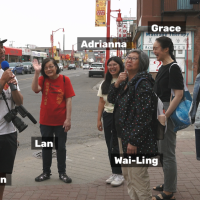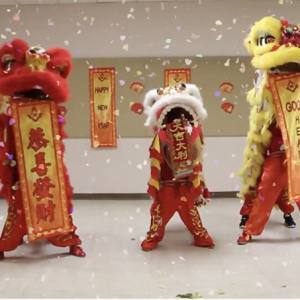YEG Chinatown Now: Chinatown Tour With Lan
Part one of web series explores 1890 to post-World War II.

A fascinating and informative tour of Edmonton’s Chinatown produced by aiya哎呀! and Fallout Media is available on STORYHIVE’s YouTube channel. The tour is hosted by Lan Chan-Marples, a Chinatown advocate who has been researching, writing, and telling the story of Edmonton’s Chinatown past and present. She is a member of aiya哎呀! – an intergenerational group of artists and community members in Edmonton’s Chinatown.
The following is a brief summary of the first episode, which covers 1890 to post-World War II. A summary of the second part will be published in the next issue of Boyle McCauley News.
—
Without visible anger or similar strong emotions, Lan Chan-Marples leads a group through the neighbourhood, describing the long and challenging history of the Chinese community in Edmonton. The underlying theme is “protesting to no avail.” Chan-Marples also uses phrases like “unfulfilled promises” and “empty words.”
In 1890, the first Chinese men, former workers on the Canadian National Railway, began to arrive in Edmonton. Two of them established a laundry where the Shaw Convention Centre currently stands. In 1892 another Chinese man established a second laundry nearby – he was escaping from racism in Calgary, where the Chinese were blamed for a smallpox epidemic. By 1899 there were 13 Chinese men in Edmonton, operating two laundries and a restaurant.
Chinese people were not welcomed by Edmonton citizens such as Frank Oliver, founder of the Edmonton Bulletin newspaper.
By 1911, there were 154 Chinese – 150 men and 4 women – living in Chinatown’s original three-block area between 97 and 98 Streets, from Jasper Avenue to 102A Avenue. By 1921, this number had increased to 518, most of them men. Clan associations were beginning to form and several different businesses were opening. The Chinese Benevolent Association was established in 1929.
In 1923, the federal government successfully introduced the Chinese Immigration Act of 1923, commonly known as the Chinese Exclusion Act, to discourage the Chinese from coming or staying in Canada. The earlier Chinese Immigration Act of 1885 imposed a head tax of $50, which was increased to $500 – an enormous amount at the time – to keep Chinese railway workers out, but this was futile. The number of immigrants from China to Canada increased to 90,000 despite the tax, which took years to pay off. During this period, the Chinese community turned inward, relying on their Chinese associations for support and social contact.
After World War II, perceptions changed and the Exclusion Act was repealed in 1947.
Anita Jenkins is a retired writer and editor who lives in Boyle Street.


